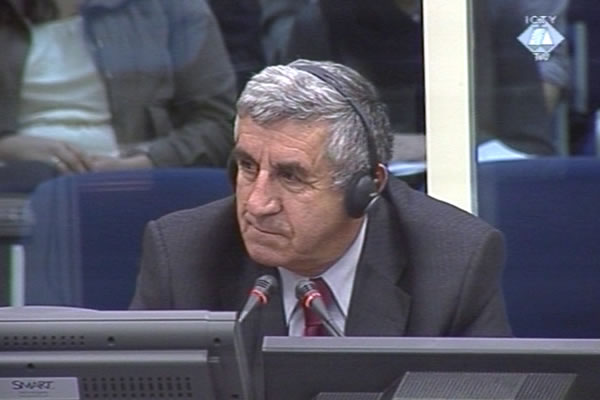Home
SIMO DRLJACA – ‘SHERIFF OF PRIJEDOR’
In a well-run state, the Prijedor police chief Simo Drljaca would end up in prison after an incident in which policemen from Prijedor murdered 200 Muslims at Koricanske Stijene. Instead, Drljaca attended a meeting with the highest-ranking officials, including the accused Stojan Zupljanin, claims former official of Bosnian Serb justice ministry
 Slobodan Avlijas, witness at the Mico Stanisic and Stojan Zupljanin trial
Slobodan Avlijas, witness at the Mico Stanisic and Stojan Zupljanin trial From May to October 1992, Slobodan Avlijas, who worked in the Republika Srpska justice ministry, visited a number of Serb municipalities to report on the conditions in prison facilities.
In a report he sent to minister Momcilo Mandic, Avlijas wrote that some 140 Muslims were detained in Bileca, in a school dormitory; they were guarded by the police. The chief of Bileca police told Avlijas that civilians had been arrested in order to be ‘protected from the attacks by the paramilitaries’. Avlijas nevertheless recommended in his report that all those older than 60 be released.
In his reports about the visits to Ilidza and Hadzici, Avlijas wrote that the police ran prison centers there. In Ilidza, the Muslim detainees were held in a high school. Another 90 prisoners were held in poor conditions in a sports center in Hadzici. The police officers in Ilidza would not allow Avlijas to enter the facility, but Avlijas knew that the school had only one toilet: ‘these are not proper conditions for prisoners to be kept’.
In late August 1992, Avlijas attended a meeting in Banja Luka with the leaders of the so-called Autonomous Region of Krajina. The Banja Luka mayor insisted on prosecuting those responsible for the murder of about 200 Muslims at Koricanske Stijene on 21 August 1992. At the meeting, nobody questioned the fact that the police from Prijedor had committed this ‘hideous massacre’, Avlijas contends. Avlijas found it ‘sickening’ because the Prijedor police chief Simo Drljaca showed no sign of ‘self-criticism or responsibility’ at all. Drljaca claimed that the suspects were out of reach of the police. ‘In a well-run state, Drljaca would have been in prison and not at a meeting with high-ranking officials’, the witness said.
The prosecutor put it to the witness that everybody at the meeting had the power to relieve Drljaca of his duty and arrest him but didn’t want to do it. The witness said that Drljaca was ‘the sheriff of Prijedor’ and ‘a role model for the deviants’. There was a real risk of a rebellion if Drljaca were arrested. Avlijas also explained that nobody could be relieved of their duty without the permission of the SDS personnel department.
Mico Stanisic’s lawyer noted that the local authorities ‘assumed the powers of the state’ and made all decisions independently. According to the defense, the crisis staff in Vogosca employed retired policeman Brana Vlaco to be in charge of the bunker in which the Muslims were detained. Vlaco was not under the police jurisdiction, the defense argued. The witness agreed that the crisis staffs did ‘play the main role’. However, the witness didn’t know that Vlaco was retired. As he explained, at the meeting Vlaco was dressed in a camouflage police uniform.
After Avlijas completed his evidence, the prosecution called the first in a series of witnesses called to confirm some adjudicated facts contested by the defense. The witness, who testified under pseudonym ST-251, is the only survivor from a group of about 20 men who were detained by the local Serb reservists in a house in the village of Kenjare in late June 1992. The Serbs then proceeded to lob explosive devices into the house and shot those who tried to escape. Finally, the house was set on fire. The witness fled to the village of Tomine but was arrested some days later by the police and the army. He was then detained with other villagers in the Krings company building in Sanski Most for a month. In the first two weeks, soldiers guarded them and their families were allowed to bring them food. Later, when the police took over guarding the prisoners, the families were no longer allowed to come and the maltreatment of the prisoners began. One man died after a beating. The witness was released after a month in detention.
Linked Reports
- Case : Zupljanin i Stanisic - "Bosnia and Herzegovina"
- 2010-10-07 PRISONERS IN ILIJAS ‘WERE CRAMMED IN LIKE SARDINES’
- 2010-10-04 WITNESS: ‘RUMORS’ ABOUT SDS CRIMES
- 2010-09-13 STATE SECURITY HAD NO INTEREST IN KERATERM MASSACRE
- 2010-10-14 NON-SERB POLICEMEN FORCED TO TAKE VACATION
- 2010-10-18 PROPERTY WAS RELINQUISHED ‘VOLUNTARILY’
- 2010-10-21 WAS ARMY IN CHARGE OF POLICE OR NOT?
